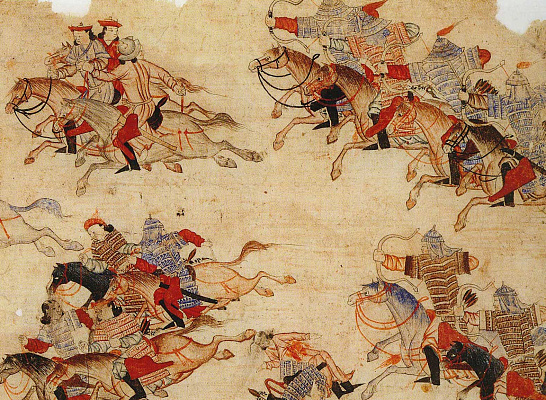The power of Genghis Khan and his descendants was so great that a political concept arose among the Turkic-Mongol peoples — only representatives of the “golden family” could rule the states founded by nomads. Even Tamerlane, who was himself the greatest conqueror, never called himself khan, contenting himself with the title gurgen (“khan’s son-in-law”), being married to a Chingizid queen wrested from his adversary. Nevertheless, there were other Mongol ruling dynasties with significant possessions in Asia. We will talk about them today.

Each ruler had to rely on the aristocracy, which itself sometimes came to power in troubled times. Thus, after the collapse of the Middle Eastern state of the Hulaguids on its fragments rose Jalairids and Chobanids, who founded their own regional powers.
The possessions of the former comprised Iraq and central and southwestern Iran, and the rulers used the Islamic title of sultans. The tribe from which they came originally lived in Mongolia, at the headwaters of the Onon River. As the closest neighbors of the Borjigin clan, the Jalayirs were the first to defect to its side and became participants in the Mongol conquests. As a result, the clan divided, its descendants became part of the Uzbeks, Hazaras, Karakalpaks and Kazakhs. And the Middle Eastern branch served the Ilkhans of Persia, its representatives often became viceroys of Baghdad, and later founded a state there.

Chobanids — in blue, Jalairids — in green
Remember the simple laborer who released young Temujin from captivity of the Taijiuts? His sons began to serve this chieftain when he himself became a powerful khan. Winding steppe roads led their descendants to Azerbaijan, where they became emirs at the court of the rulers of the Hulaguid state. At the beginning of the 14th century, the head of the family was a certain Choban, a commander at the court of three Mongol khans, from whom the dynasty was named. The Chobanids took possession of the historical region of Azerbaijan, including Tabriz, the old Ilkhan capital. Therefore, they were considered the main ruling clan in the Middle Eastern Mongol world until they were swept away.
The territory of historical Khorezm after its conquest was divided between the tsarevitch Djuchi and Chagatai, becoming part of their ulus. As the Golden Horde disintegrated, the Sufid dynasty, originating from the Mongol tribe of Kungrat, began to rule in the lower reaches of the Amu Darya. To be more precise, its founder was the brother of Khanshi Borte, the main and favorite wife of Genghis Khan. In the end, Khorezm was forced to submit to Tamerlane, however, the Sufis as vassal rulers owned it for more than a hundred years.
Mongolian origin from the tribe of Mangyts had Yedigeevichs, the rulers of the united Nogai Horde and less significant principalities formed after its disintegration in the middle of the 16th century. The founder of the dynasty was Yedigei, the last beklarbek of the unified ulus of Juchi, who eventually turned his arms against Tokhtamysh. His possessions were located between the Urals and the Volga, where the Nogai yurt, ruled by his descendants, later emerged.
From the 15th century, the eastern Mangyts began to be perceived as one of the Uzbek tribes. Together with Chingizid Sheibani-khan at the beginning of the next century they took part in the conquest of Maverannahr. For a long time this clan was the basis of strength of Bukhara khans, but then seized the throne itself when troubled times came. From 1720 until the revolution Bukhara was ruled by the Mangyt dynasty.
In the neighboring Khanate of Khiva initially sat the Arabshahids, Chingizids and relatives of Bukhara Khan. But with the passage of time the dynasty died out, and the local nobility began to invite Kazakh tsareviches to the throne. Then this practice bored them, and a struggle began between the pretenders to power. The Kungrat dynasty, originating from the Turkicized Mongolian tribe of the same name, won the struggle. Until 1920 its representatives sat on the throne.
The descendants of the great Tamerlane eventually abandoned the idea of ruling the empire on behalf of the puppet Genghisids. They began to rely on Islamic identity and ruled the country not as descendants of Genghis Khan, but as Muslim sovereigns. The Timurid dynasty, like its Indian descendants the Great Moguls, descended from the Mongol tribe of the Barlas.
The Taishi and then the Khans of the Kalmyk Khanate came from the Mongolian tribe of Kereit. At the end of the 12th century, this tribe converted to Christianity and occupied a significant position on the Mongolian Plateau, then it was ruled by Esugei Bagatur’s twin — Van-khan. But later this leader did not share power with his son, the Kereites were conquered by Genghis Khan and did not play a separate role. If we talk about the rulers of the states of other western Mongols, like the Khoshut and Dzungar Khanate, there was an elective monarchy. This prevented the formation of strong dynasties, but all sovereigns invariably came from the old Mongol tribes.
We can also think of the Kidan states — the first existed in Northern China, and the second emerged in Central Asia after migration as a result of the Jurchen expansion. The Kidans were cousins of the medieval Mongols, and they were ruled by the Yelui dynasty.
Also, Al-Adil Kitbugu, the ruler of the Egyptian Mamluk state at the end of the 13th century, is a nonsense. He was a natural Mongol by blood, but was captured by the Egyptians during a battle with the Hulaguid army. Kitbuga was taken by the Sultan into his service, and in time he himself became the head of the Mamluk power. However, he did not found a dynasty — the throne in Egypt was passed between successful generals.
